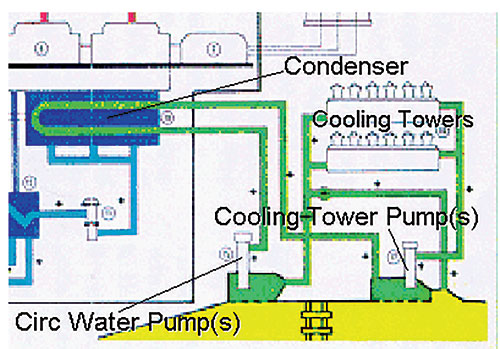Power generation plants face difficulty when conserving water, regardless of size or fuel source. For wet cooling in particular, efficiency of the cooling tower and a typical 5 percent evaporation rate mean thousands of gallons of water evaporate per day. The total cost of water loss increases when considering the water source and disposal costs.
Plants always require some form of cooling. Cooling tower systems offer several opportunities to reduce energy and operational costs.
In power plants, energy projects often pass through financial scrutiny. As a result, operational costs weigh heavily on the decision to approve the project. An intelligent control system can produce savings in 75 percent of a cooling tower system’s total cost of operation. Plans to optimize a cooling tower system must achieve both energy efficiency and sound financial savings.
Sophisticated Controls
Microprocessors and controllers have become more cost-effective during the last few decades. End users have applied these sophisticated controls to more simple applications at the local level. However, most are not software experts—controls must be set up and “tweaked” to best operate cooling tower systems.
 Figure 1. A power plant cooling system (Graphic courtesy of Schneider Electric)
Figure 1. A power plant cooling system (Graphic courtesy of Schneider Electric)Annual outsourced software training at the plant is usually necessary to refresh experienced operators and train new ones. Without outside training, end users often override or abandon the software and place equipment in manual or “hand” mode. This eliminates energy-savings potential and increases costs from equipment wear.
When applied to circulating pumps and fans, variable frequency drives (VFDs) not only reduce water evaporation and save energy but also minimize wear on pumps and motors. Avoiding the costs of repairing and replacing parts will directly improve the bottom line.
Saving water also means reducing the costs associated with water supply and disposal. Incorporating a sophisticated control through a microprocessor-based control system can monitor the wet-bulb outside air temperature and the change in temperature of the supply and return water. The control can also vary the speed of the pump and fan motors while resetting the cooling tower system’s water temperature. The software will calculate the optimum points where the best mix of water temperature and flow meet for a specific system.
With the proper system, end users can minimize energy consumption, water evaporation rate and disposal costs while extending pump and motor life. An intuitive microprocessor-based system prevents the need for annual outside software training.
The keys to success are the software that drives the controllers and the ease of operation of the complete control system. The end user must meet the plant’s cooling requirements and avoid driving the operation out of an acceptable range. These difficult tasks are made simple with the right system in place.
Operational Savings
Although energy savings are more popular, the maintenance benefits of VFDs represent a significant savings opportunity. Pump maintenance costs command 25 percent of lifetime costs. Cooling tower applications can take advantage of the protection VFDs offer from unexpected shutdowns.
When operators apply a preventive maintenance plan for power plant equipment, they can predict potential failures before they occur. Some plants take preventive maintenance further with condition-based maintenance, an approach that requires operators to predict equipment condition over time. All operators must be ready to react to unexpected equipment emergencies.
VFDs can provide specific monitoring and protect against cavitation, dry run, low pressure and inlet/outlet pressure.
Protective monitoring, along with remote signaling via embedded Web servers, can provide early warning alarms to centralized maintenance teams. It also provides planned maintenance activity and can prevent pump system failure.
In addition to providing real-time feedback, remote monitoring eliminates operating costs associated with local monitoring—the traditional approach to gathering process feedback.
Optimization goes beyond energy savings and has a major impact on the bottom line. Applying intelligent VFD control to condenser pumps and tower fans takes control to the next level. This technology can justify project costs for finance departments by reducing operational and energy costs.


